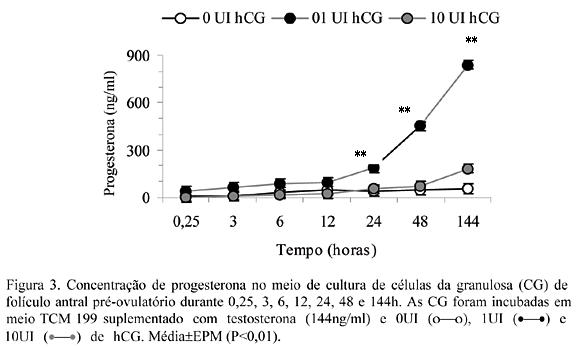The role of the human chorionic gonadotropin (hCG) and testosterone was evaluated in the progesterone (P4) and estradiol-17beta (E2) production by granulosa cells of antral follicles from mare cultivated in vitro. The treatment (groups) with gonadotropin consisted of: 1- control (no added hormone); 2- 1 IU hCG (0.3mg/ml) and 3- 10 IU hCG (3.0mg/ml). The treatment with hCG was carried out in the presence or not of testosterone (144ng/ml). The culture medium was collected and replaced at 0.25, 3, 6, 12, 24 and 144h of culture. The concentrations of P4 and E2 were measured by radioimunoassay. Analyses of variance were used for P4 and E2, and mean of the factors were compared by the Tukey test at 5% of probability. No difference was observed between 1 and 2 groups. Treatment with 1 IU of hCG increased progesterone concentration after 24h of culture (P<0.01), only in the presence of testosterone. The concentration of estradiol increased in the presence of testosterone, reaching maximum concentration with 6h of culture (P<0.01), and reduced gradually until the observed concentration at 0.25h of culture. The addition of hCG had no effect in the synthesis of this steroid. The testosterone modulates the action of the luteinizing hormone in the differentiation and luteinization of the granulosa cells and plays important estimulator effect in the synthesis/secretion of E2 by granulosa cells in vitro of presumptive pre-ovulatory antral follicle in mare.
mare; luteinizing hormone; testosterone; steroidogenesis; granulosa cell




